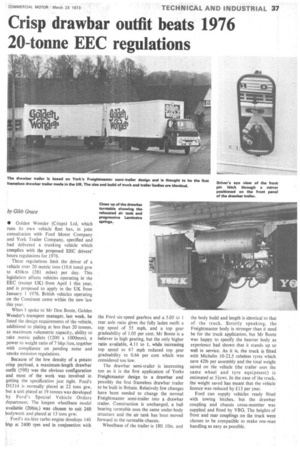Crisp drawbar outfit beats 1976 20-tonne EEC regulations
Page 35

If you've noticed an error in this article please click here to report it so we can fix it.
by Gibb Grace
• Golden Wonder. (Crisps) Ltd, which runs its own vehicle fleet has, in joint consultation with Ford Motor Company and York Trailer Company, specified and had delivered a trunking vehicle which complies with the proposed EEC drivers' hours regulations for 1976.
These regulations limit the driver of a vehicle over 20 metric tons (19.6 tons) gvw to 450km (281 miles) per day. This legislation affects vehicles operating in the EEC (except UK) from April 1 this year, and is proposed to apply in the UK from January 1 1976. British vehicles operating on the Continent come within the new law this year.
When 1 spoke to Mr Don Boote, Golden Wonder's transport manager, last week, he listed the design requirements of the vehicle, additional to plating at less than 20 tonnes, as maximum volumetric capacity, ability to take metric pallets (1200 x 1000mm), a power to weight ratio of 7 bhp /ton, together with compliance on pending noise and smoke emission regulations.
Because of the low density of a potato crisp payload, a maximum-length drawbar outfit (59ft) was the obvious configuration and most of the work was involved in getting the specification just right. Ford's D 1314 is normally plated at 22 tons gtw, but a unit plated at 19 tonnes was developed by Ford's Special Vehicle Orders department. The longest wheelbase model available (206in.) was chosen to suit 24ft bodywork and plated at 13 tons gvw:
Ford's six-litre turbo engine develops 140 bhp at 2400 rpm and in conjunction with
the Ford six-speed gearbox and a 5.05 to 1 rear axle ratio gives the fully laden outfit a top speed of 55 mph, and a top gear gradeability of 1.05 per cent. Mr Boote is a believer in high gearing, but the only higher ratio available, 4.11 to 1, while increasing top speed to 67 mph reduced top gear gradeability to 0.66 per cent which was considered too low.
The drawbar semi-trailer is interesting too as it is the first application of Yorks Freightmaster design to a drawbar and possibly the first frameless drawbar trailer to be built in Britain. Relatively few changes have been needed to change the normal Freightmaster semi-trailer into a drawbar trailer. Construction is unchanged, a ball bearing turntable uses the same under-body structure and the air tank has been moved forward to the turntable chassis.
Wheelbase of the trailer is 18ft 10in. and the body build and length is identical to that of. the truck. Strictly speaking, the Freightmaster body is stronger than it need be for the truck application, but Mr Boote was happy to specify the heavier body as experience had shown that it stands up so well in service. As it is, the truck is fitted with Michelin 10-22.5 tubeless tyres which save 42Ib per assembly and the total weight saved on the vehicle (the trailer uses the same wheel and tyre equipment) is estimated at 54-cwt. In the case of the truck, the weight saved has meant that the vehicle licence was reduced by i13 per year.
Ford can supply vehicles ready fitted with towing hitches, but the drawbar coupling and chassis cross-member was supplied and fitted by VBG. The heights of front and rear couplings on the truck were chosen to be compatible to make one-man handling as easy, as possible.












































































































